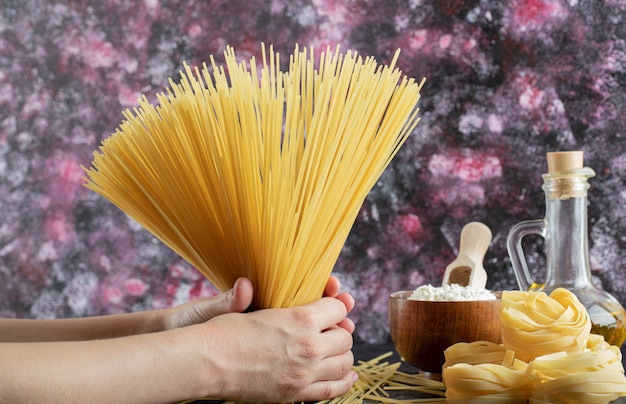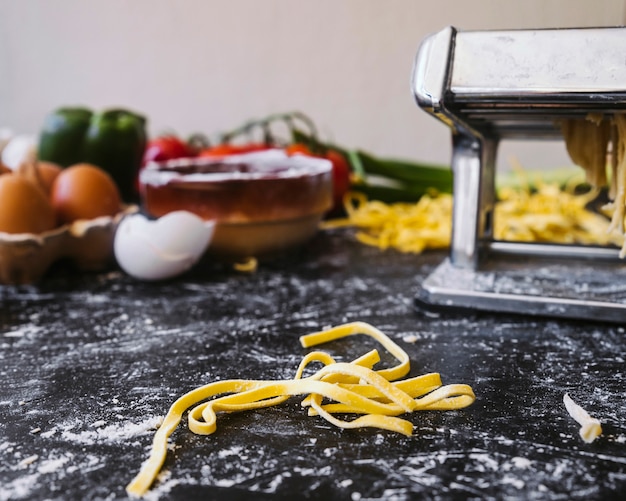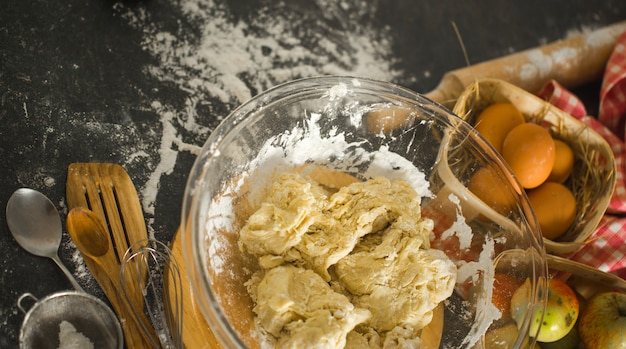Linguine. Just the word evokes images of long, silky strands of pasta coated in a rich, flavorful sauce, doesn't it? It's a classic for a reason - it's versatile, delicious, and surprisingly easy to cook perfectly. But, like any good pasta, getting the timing right is crucial. Cook it too long, and you'll end up with mushy, sad noodles. Cook it too short, and you'll be chewing on something akin to rubber bands. Nobody wants that, right?
So, buckle up, pasta enthusiasts! This article is your comprehensive guide to cooking linguine like a pro. We'll dive into the perfect cooking times, the tell-tale signs of perfectly cooked pasta, and some handy tips that'll ensure your linguine is always al dente and delightful. I'll even share some of my personal favourite recipes that I swear by. Get ready for a pasta masterclass, my friends!
Part 1: The Basics

Understanding the Variables
First things first, there's no magic number when it comes to cooking time for linguine. It depends on a few factors that you need to consider:
- The brand and shape of the pasta: Some brands are thicker or thinner, while different shapes can significantly affect cooking time. Have you ever encountered those impossibly thin, ribbon-like linguine? They cook much faster than the chunky, wider strands.
- The size of your pot and the amount of water: A smaller pot with less water might bring the pasta to a boil quicker, but it might also require a slightly longer cooking time to ensure even cooking.
- Your personal preference: Some like it al dente, others prefer a softer texture. I, for one, am a die-hard al dente fan, but I'll break down all the signs to look for regardless of your preference.
The Golden Rule (With a Twist)
Most linguine packages recommend a cooking time of 8-10 minutes. This is a good starting point, but it's important to remember that it's just that: a starting point. Every batch of pasta, every pot, and every stovetop is different. So, don't treat that number as gospel. Instead, think of it as your guide. You’ll want to keep a close eye on your pasta to ensure it’s cooked to your liking.
Part 2: Mastering the Art of Checking

The Taste Test: A Timeless Classic
It's the tried and true method for a reason! After about 8 minutes, carefully fish a strand of linguine out of the pot with a spoon. Give it a little twirl, then bite into it. Is it still hard? Give it another minute or two. Is it soft and mushy? You've overcooked it. You're aiming for that perfect al dente texture, a firm but not hard bite.
The Visual Test: Clues for the Observant Cook
If you're unsure about the taste test, there are a few visual cues to look for. Perfectly cooked linguine will have a slightly cloudy appearance, a subtle departure from its initially bright white colour. Also, notice the curve. It should have a slight bend to it, not as straight as an arrow. If it's still stubbornly straight, it's likely not done yet.
Part 3: Avoiding the Common Pitfalls

Overcrowding the Pot: A Recipe for Uneven Cooking
One of the biggest mistakes you can make is cramming too much pasta into the pot. This creates a chaotic situation where the pasta doesn’t have room to cook evenly, leading to some perfectly cooked strands and some that are still rock hard. The solution? Don’t add all the pasta at once. Add it in batches, ensuring it has enough space to move freely and cook properly. Your pasta will thank you for it.
Stirring Too Much: A Recipe for Breakage and Clumps
While you don’t want to leave the pasta to its own devices, stirring too much can cause it to break or stick together. Think of it more like a gentle dance. Stir gently but effectively, just enough to ensure even cooking. No need to turn it into a pasta smoothie!
Part 4: Expert Tips and Tricks for Perfect Pasta
Salt: The Unsung Hero of pasta cooking
Never skimp on the salt! It's crucial for flavor and for ensuring your pasta cooks properly. Think of it as seasoning your pasta water like you would season a soup or stew. Always add a generous pinch of salt to the boiling water before adding the pasta. Trust me, the difference is noticeable.
Olive Oil or Butter: A Little Extra Flavor
Adding a tablespoon of olive oil or a knob of butter to the boiling water is a common practice. It supposedly helps prevent the pasta from sticking together. Personally, I haven’t noticed a huge difference, but if you want to add a little extra flavor, go for it!
Don’t Rinse: A Culinary Crime
Rinsing your pasta is a big no-no. It washes away the starch that helps the sauce cling to the pasta. I used to be a pasta rinser myself, thinking it would make the pasta cleaner. Big mistake! Once you experience the magic of sauce-slathered pasta, you'll never rinse again.
Part 5: Serving Up Perfection: Mastering the Finishing Touches
The Right Sauce: A Match Made in Pasta Heaven
Linguine is wonderfully versatile and pairs beautifully with a wide range of sauces. But, for a truly perfect dish, choose a sauce that complements the pasta's texture and flavour. I adore linguine with a simple tomato sauce, a creamy pesto, or a rich and flavorful seafood sauce. Experiment and find what you love!
Don’t Overcook the Sauce: Maintaining Harmony
After draining your pasta, toss it into your sauce immediately. You don’t want the sauce to thicken excessively while you wait. If your sauce needs heating, do it separately while the pasta cooks. This way, everything is perfectly cooked and ready to mingle.
Part 6: Beyond the Basics: Special Situations
Cooking for a Crowd: Pasta Party Planning
When you're cooking for a group, ensuring everyone gets pasta cooked to their liking can be tricky. Here are a few strategies to make your pasta party a success:
- Cook the pasta in batches: This ensures enough room in the pot for the pasta to cook evenly and without sticking.
- Don’t overcook the pasta: It's better to have slightly undercooked pasta than overcooked. You can always add a little more cooking time if needed.
- Serve immediately: The key to perfect pasta is to serve it straight from the pot. If you need to keep it warm, use a serving dish, but serve it as soon as possible.
Cooking with Thick Sauces: Adjusting for Texture
Thick sauces, like creamy pesto or a rich meat sauce, can cling to the pasta more than others. In these cases, you might want to cook your linguine a minute or two less than the package instructions suggest. This prevents it from becoming mushy when tossed with the sauce.
Cooking in a Pan: Short and Sweet
I love the convenience of cooking linguine in a pan, especially for quick weeknight meals. However, you need to be careful not to overcook the pasta. The best approach is to add the pasta to the pan just before the sauce is ready. This allows the pasta to cook in the sauce, absorbing all the delicious flavour. Just keep a close eye on it so you don't end up with a mushy mess.
Part 7: My Favourite Linguine Recipes: A Taste of What’s to Come
Now that we’ve covered the basics, let's get cooking! Here are a few of my personal favourite linguine recipes that I can't wait to share with you.
Classic Tomato Sauce: A Simple Yet Delicious Staple
This simple yet incredibly delicious sauce is perfect for a weeknight meal. You'll need some diced tomatoes, onions, garlic, and a few herbs.
- Sauté the onions and garlic in olive oil until softened.
- Add the tomatoes and herbs, and bring to a simmer.
- Let the sauce cook for at least 30 minutes, or until it’s thickened.
- Season with salt and pepper to taste.
- Toss the cooked linguine with the sauce, and enjoy!
Creamy Pesto: A Classic for a Reason
This classic is flavourful, simple, and ready in minutes. You can make your own pesto, but I often use store-bought. Here's the recipe:
- Cook your linguine according to the package directions.
- While the pasta is cooking, heat a tablespoon of olive oil in a pan.
- Add a cup of heavy cream and bring it to a simmer.
- Stir in your pesto, and season with salt and pepper to taste.
- Add the cooked linguine to the pan and toss to coat.
Seafood Linguine: A Crowd-Pleasing Feast
This is a crowd-pleasing dish that's perfect for a special occasion. You can use whatever seafood you like, but my personal favourite is a combination of shrimp, clams, and mussels. Here's the recipe:
- Heat some olive oil in a large skillet.
- Add the seafood and cook until it’s cooked through.
- Add a cup of white wine and bring it to a simmer.
- Season with salt and pepper to taste.
- Add the cooked linguine to the skillet and toss to coat.
Part 8: FAQs
How do I know if my linguine is overcooked?
Overcooked linguine will be mushy and soft. It might also be a bit sticky, and the texture will be quite unpleasant. If you're not sure, taste a piece. If it's too soft, you know it's overcooked. Don't fear a slightly undercooked texture, it's better than mushy any day!
Can I add my pasta sauce to the pot of boiling water?
I would strongly advise against this. It might seem like a shortcut, but it doesn’t really improve the taste or the texture. The sauce can interfere with the cooking process and affect the final result. It’s best to keep the sauce separate until the pasta is cooked.
What if I don’t have enough water to cook my linguine?
It’s essential to use enough water to ensure the pasta cooks evenly and without sticking together. You should have about 1 inch of water above the pasta. If you don’t have enough water, it’s best to cook the pasta in batches.
What’s the best way to store leftover linguine?
Store leftover linguine in an airtight container in the refrigerator. You can toss it with a little bit of olive oil to prevent it from sticking together. It’s best to eat it within a day or two. Leftover linguine is great for a quick and easy lunch or dinner.
What are some other pasta shapes that I can try?
Once you’ve mastered the art of cooking linguine, you can experiment with other pasta shapes. Some other popular shapes include spaghetti, penne, fettuccine, and ravioli. Each shape has its own unique texture and flavour, and they all pair well with different sauces. It’s all about finding your favourites!
I hope you've enjoyed this comprehensive guide to cooking linguine. Remember, there's no one-size-fits-all answer when it comes to pasta cooking. The key is to be patient, observant, and to always trust your taste buds. Happy cooking!
Everyone is watching

How to Cook Frozen Lobster Tails Perfectly: A Step-by-Step Guide
RecipesLobster. Just the word conjures up images of lavish meals, special occasions, and a taste of luxury. But let's...

Pigs in a Blanket Cooking Time: How Long to Bake for Perfect Results
RecipesAh, pigs in a blanket. Just the name conjures up images of those delightful little parcels of crispy pastry en...

Pork Fillet Cooking Time: How Long to Cook It Perfectly
RecipesPork fillet, or tenderloin as it's sometimes called, is a real favourite in our house. It's so versatile, and...

The Ultimate Guide to Tender, Juicy Pulled Pork
RecipesRight, let's talk pulled pork. It's one of those dishes that just screams "comfort food," doesn't it? I mean...

The Ultimate Guide to Cooking Sweet Potatoes: From Roasting to Mashing
RecipesSweet potatoes. Just the name conjures up images of warm, comforting dishes, bursts of vibrant color, and a to...
